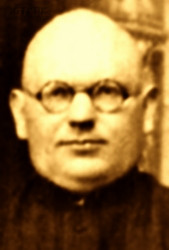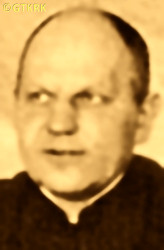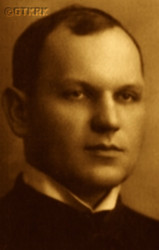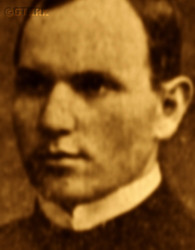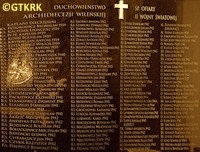Roman Catholic
St Sigismund parish
05-507 Słomczyn
85 Wiślana Str.
Konstancin deanery
Warsaw archdiocese, Poland
full list:
displayClick to display full list

searchClick to search full list by categories
wyświetlKliknij by wyświetlić pełną listę po polsku

szukajKliknij by przeszukać listę wg kategorii po polsku

Martyrology of the clergy — Poland
XX century (1914 – 1989)
personal data
religious status
Servant of God
surname
GODLEWSKI
forename(s)
Vincent (pl. Wincenty)
function
diocesan priest
creed
Latin (Roman Catholic) Church RCmore on
en.wikipedia.org
[access: 2014.09.21]
diocese / province
Vilnius archdiocesemore on
en.wikipedia.org
[access: 2013.05.19]
Minsk diocesemore on
en.wikipedia.org
[access: 2013.05.19]
Vilnius diocesemore on
en.wikipedia.org
[access: 2013.05.19]
academic distinctions
Theology MA
nationality
Belarusian
date and place
of death
24.12.1942

Maly Trostenetstoday: Novyi Dvor ssov., Minsk dist., Minsk reg., Belarus
more on
be.wikipedia.org
[access: 2022.07.16]
details of death
On 22.06.1925 arrested by Polish authorities for organisation of Belarusian political demonstrations, promoting Belarusian anthem „We've slept for long” among children and leading to Polish–Belarus incidents in his parish — earlier, he introduced the Belarusian language into his sermons without the knowledge and consent of the diocesan authorities.
Jailed in Lukiškės prison in Vilnius.
On 01.03.1926 sentenced to 2 years in prison — appeal was rejected on 27.01.1927.
Jailed in Rakowiecka prison in Warsaw — apparently with a number of breaks for he was rearrested few times and brought back to prison.
After German and Russian invasion of Poland in 09.1939 and start of the World War II, after start if Russian occupation of the Belarus territory moved to Lithuanian Kovno.
co‐founder of Belarus National Party.
In 06.1940, after annexation of Lithuania by the Russians moved to German–occupied Warsaw in General Governorate.
In 06.1941 took part in organization of Belarus National Centre in Berlin.
After German attack on 22.06.1941 of their erstwhile ally, Russians, chief school inspector at General Commissariat „Belarus”, German–occupied territorial government.
Signatory of an appeal to Belarus society for a struggle against communism alongside German army.
Arrested during the night of 23/24.12.1942 and the same day murdered in the Maly Trostenets extermination camp or by the other Belarusian nationalists.
cause of death
murder
perpetrators
Germans / Belarusians
sites and events
GeneralgouvernementClick to display the description, Ribbentrop‐MolotovClick to display the description, Pius XI's encyclicalsClick to display the description, Vilnius (Lukiškės)Click to display the description, Warsaw (Mokotów)Click to display the description
date and place
of birth
16.11.1886

Shurichitoday: Novyi Dvor ssov., Svislach dist., Grodno reg., Belarus
more on
be.wikipedia.org
[access: 2023.01.18]
alt. dates and places
of birth
16.12.1886
parents
GODLEWSKI John
🞲 ?, ? — 🕆 ?, ?

DZIEMIAŃCZYK Catherine
🞲 ?, ? — 🕆 ?, ?
presbyter (holy orders)
ordination
1914

positions held
1928 – 1939
chaplain — Vilniustoday: Vilnius city dist., Vilnius Cou., Lithuania
more on
en.wikipedia.org
[access: 2022.01.06] ⋄ St Joseph Opthalmic Institute ⋄ St Joseph Spouse of the Blessed Virgin Mary RC chapel ⋄ Vilniustoday: Vilnius city dist., Vilnius Cou., Lithuania
more on
en.wikipedia.org
[access: 2022.01.06] RC deanery
1928 – 1939
prefect — Vilniustoday: Vilnius city dist., Vilnius Cou., Lithuania
more on
en.wikipedia.org
[access: 2022.01.06] ⋄ Benedictine OSB and Visitandines VSM nun's chools
1921 – 1927
parish priest — Zhodishkitoday: Zhodishki ssov., Smarhon dist., Grodno reg., Belarus
more on
be.wikipedia.org
[access: 2023.01.18] ⋄ Holy Trinity RC parish ⋄ Svirtoday: Svir ssov., Myadzyel dist., Minsk reg., Belarus
more on
be.wikipedia.org
[access: 2023.01.18] RC deanery
1918 – 1921
curatus/rector/expositus — Nyasvizhtoday: Nyasvizh dist., Minsk reg., Belarus
more on
en.wikipedia.org
[access: 2023.12.15] ⋄ St Euphemia (of Benedictine Nuns) RC church ⋄ Corpus Christi RC parish ⋄ Nyasvizhtoday: Nyasvizh dist., Minsk reg., Belarus
more on
en.wikipedia.org
[access: 2023.12.15] RC deanery — also: prefect of elementary schools
c. 1918
professor — Minsktoday: Minsk city reg., Belarus
more on
en.wikipedia.org
[access: 2020.07.31] ⋄ Theological Seminary (Belorusian)
1916 – 1918
vicar — Minsktoday: Minsk city reg., Belarus
more on
en.wikipedia.org
[access: 2020.07.31] ⋄ Name of the Blessed Virgin Mary RC parish ⋄ Minsktoday: Minsk city reg., Belarus
more on
en.wikipedia.org
[access: 2020.07.31] RC deanery
1912 – 1916
student — Sankt Petersburgtoday: Saint Petersburg city, Russia
more on
en.wikipedia.org
[access: 2020.07.31] ⋄ philosophy and theology, Imperial Roman Catholic Spiritual Academy (1842‐1918)
1908 – 1912
student — Vilniustoday: Vilnius city dist., Vilnius Cou., Lithuania
more on
en.wikipedia.org
[access: 2022.01.06] ⋄ philosophy and theology, Theological Seminary
translator — i.a. of the New Testament into Belarusian
Belarusian social and political activist, founder of the Belarusian National Front (1936) and the Belarusian Christian–Democratic Union
publisher — magazine, „Belarusian Front”
others related
in death
STANKIEWICZClick to display biography Adam, MIODUSZEWSKIClick to display biography Anthony, BOHATKIEWICZClick to display biography Mieczyslav, GLAKOWSKIClick to display biography Stanislav, HLEBOWICZClick to display biography Henry, KASZYRAClick to display biography George, LESZCZEWICZClick to display biography Anthony, LUBECKIClick to display biography Alexander, LUBIANIECClick to display biography Charles, MALECClick to display biography Dennis, MARCINIAKClick to display biography Isidore, RYBAŁTOWSKIClick to display biography Casimir, ŚWIATOPEŁK–MIRSKIClick to display biography Anthony, WIECZOREKClick to display biography Vladislav
sites and events
descriptions
Generalgouvernement: After the Polish defeat in the 09.1939 campaign, which was the result of the Ribbentrop‐Molotov Pact and constituted the first stage of World War II, and the beginning of German occupation in part of Poland (in the other, eastern part of Poland, the Russian occupation began), the Germans divided the occupied Polish territory into five main regions. In two of them new German provinces were created, two other were incorporated into other provinces. However, the fifth part was treated separately, and in a political sense it was supposed to recreate the German idea from 1915 (during World War I, after the defeat of the Russians in the Battle of Gorlice in 05.1915) of creating a Polish enclave within Germany. Illegal in the sense of international law, i.e. Hague Convention, and public law, managed by the Germans according to separate laws — especially established for the Polish Germ. Untermenschen (Eng. subhumans) — till the Russian offensive in 1945 it constituted part of the Germ. Großdeutschland (Eng. Greater Germany). Till 31.07.1940 formally called Germ. Generalgouvernement für die besetzten polnischen Gebiete (Eng. General Government for the occupied Polish lands) — later simply Germ. Generalgouvernement (Eng. General Governorate), as in the years 1915‐1918. From 07.1941, i.e. after the German attack on 22.06.1941 against the erstwhile ally, the Russians, it also included the Galicia district, i.e. the Polish pre‐war south‐eastern voivodeships. A special criminal law was enacted and applied to Poles and Jews, allowing for the arbitrary administration of the death penalty regardless of the age of the „perpetrator”, and sanctioning the use of collective responsibility. After the end of the military conflict of the World War UU, the government of the Germ. Generalgouvernement was recognized as a criminal organization, and its leader, governor Hans Frank, guilty of war crimes and crimes against humanity and executed. (more on: en.wikipedia.orgClick to attempt to display webpage
[access: 2024.12.13])
Ribbentrop‐Molotov: Genocidal Russian‐German alliance pact between Russian leader Joseph Stalin and German leader Adolf Hitler signed on 23.08.1939 in Moscow by respective foreign ministers, Mr. Vyacheslav Molotov for Russia and Joachim von Ribbentrop for Germany. The pact sanctioned and was the direct cause of joint Russian and German invasion of Poland and the outbreak of the World War II in 09.1939. In a political sense, the pact was an attempt to restore the status quo ante before 1914, with one exception, namely the „commercial” exchange of the so‐called „Kingdom of Poland”, which in 1914 was part of the Russian Empire, fore Eastern Galicia (today's western Ukraine), in 1914 belonging to the Austro‐Hungarian Empire. Galicia, including Lviv, was to be taken over by the Russians, the „Kingdom of Poland” — under the name of the General Governorate — Germany. The resultant „war was one of the greatest calamities and dramas of humanity in history, for two atheistic and anti‐Christian ideologies — national and international socialism — rejected God and His fifth Decalogue commandment: Thou shall not kill!” (Abp Stanislav Gądecki, 01.09.2019). The decisions taken — backed up by the betrayal of the formal allies of Poland, France and Germany, which on 12.09.1939, at a joint conference in Abbeville, decided not to provide aid to attacked Poland and not to take military action against Germany (a clear breach of treaty obligations with Poland) — were on 28.09.1939 slightly altered and made more precise when a treaty on „German‐Russian boundaries and friendship” was agreed by the same murderous signatories. One of its findings was establishment of spheres of influence in Central and Eastern Europe and in consequence IV partition of Poland. In one of its secret annexes agreed, that: „the Signatories will not tolerate on its respective territories any Polish propaganda that affects the territory of the other Side. On their respective territories they will suppress all such propaganda and inform each other of the measures taken to accomplish it”. The agreements resulted in a series of meeting between two genocidal organization representing both sides — German Gestapo and Russian NKVD when coordination of efforts to exterminate Polish intelligentsia and Polish leading classes (in Germany called «Intelligenzaktion», in Russia took the form of Katyń massacres) where discussed. Resulted in deaths of hundreds of thousands of Polish intelligentsia, including thousands of priests presented here, and tens of millions of ordinary people,. The results of this Russian‐German pact lasted till 1989 and are still in evidence even today. (more on: en.wikipedia.orgClick to attempt to display webpage
[access: 2015.09.30])
Pius XI's encyclicals: Facing the creation of two totalitarian systems in Europe, which seemed to compete with each other, though there were more similarities than contradictions between them, Pope Pius XI issued in 03.1937 (within 5 days) two encyclicals. In the „Mit brennender Sorge” (Eng. „With Burning Concern”) published on 14.03.1938, condemned the national socialism prevailing in Germany. The Pope wrote: „Whoever, following the old Germanic‐pre‐Christian beliefs, puts various impersonal fate in the place of a personal God, denies the wisdom of God and Providence […], whoever exalts earthly values: race or nation, or state, or state system, representatives of state power or other fundamental values of human society, […] and makes them the highest standard of all values, including religious ones, and idolizes them, this one […] is far from true faith in God and from a worldview corresponding to such faith”. On 19.03.1937, published „Divini Redemptoris” (Eng. „Divine Redeemer”), in which criticized Russian communism, dialectical materialism and the class struggle theory. The Pope wrote: „Communism deprives man of freedom, and therefore the spiritual basis of all life norms. It deprives the human person of all his dignity and any moral support with which he could resist the onslaught of blind passions […] This is the new gospel that Bolshevik and godless communism preaches as a message of salvation and redemption of humanity”… Pius XI demanded that the established human law be subjected to the natural law of God , recommended the implementation of the ideal of a Christian state and society, and called on Catholics to resist. Two years later, National Socialist Germany and Communist Russia came together and started World War II. (more on: www.vatican.vaClick to attempt to display webpage
[access: 2023.05.28], www.vatican.vaClick to attempt to display webpage
[access: 2023.05.28])
Vilnius (Lukiškės): Vilnius prison used both by Russians and Germans. Thousands of Poles were kept there. From 2,000 to 16,000 prisoners were jailed at any time there. In 06.1941, after German invasion, Russians murdered most of the prisoners. (more on: en.wikipedia.orgClick to attempt to display webpage
[access: 2021.07.04])
Warsaw (Mokotów): Prison and detention centre in Warsaw on Rakowiecka Str. Used by Germans during German occupation 1939‐1945 to held thousands of Poles. In 1945‐1956 thousands of Polish independence activists were held there by the Polish Commie‐Nazi branch of Russian NKVD/KGB police. Hundreds of Poles were executed. (more on: pl.wikipedia.orgClick to attempt to display webpage
[access: 2013.08.17])
sources
personal:
www.bialystok.opoka.org.plClick to attempt to display webpage
[access: 2013.01.06], kamunikat.orgClick to attempt to display webpage
[access: 2013.01.06], newsaints.faithweb.comClick to attempt to display webpage
[access: 2021.12.19], www.kresy.plClick to attempt to display webpage
[access: 2013.01.06], pl.wikipedia.orgClick to attempt to display webpage
[access: 2014.08.14]
bibliographical:
„Vilnius archdiocese clergy martyrology 1939‐1945”, Fr Thaddeus Krahel, Białystok, 2017
original images:
commons.wikimedia.orgClick to attempt to display webpage
[access: 2017.05.20], catholic.byClick to attempt to display webpage
[access: 2020.07.31], www.ngopole.plClick to attempt to display webpage
[access: 2013.08.10], nn.byClick to attempt to display webpage
[access: 2017.05.20], mfront.netClick to attempt to display webpage
[access: 2014.08.14], www.ciekawepodlasie.plClick to attempt to display webpage
[access: 2020.07.31]
LETTER to CUSTODIAN/ADMINISTRATOR
If you have an Email client on your communicator/computer — such as Mozilla Thunderbird, Windows Mail or Microsoft Outlook, described at WikipediaPatrz:
en.wikipedia.org, among others — try the link below, please:
LETTER to CUSTODIAN/ADMINISTRATORClick and try to call your own Email client
If however you do not run such a client or the above link is not active please send an email to the Custodian/Administrator using your account — in your customary email/correspondence engine — at the following address:

giving the following as the subject:
MARTYROLOGY: GODLEWSKI Vincent
To return to the biography press below:
 Click to return to biography
Click to return to biography








